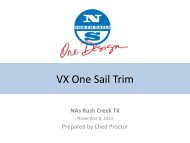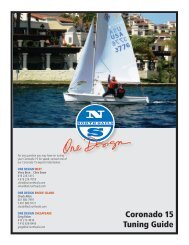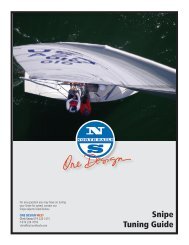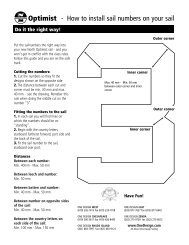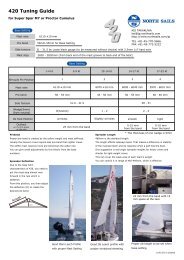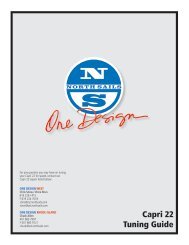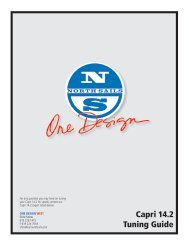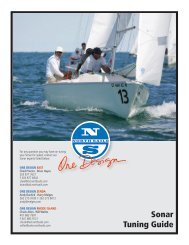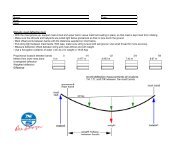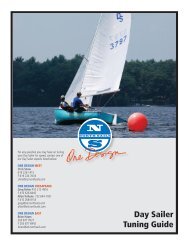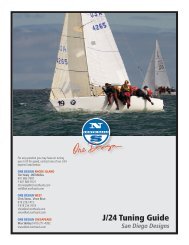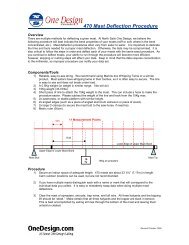Shields Tuning Guide - North Sails - One Design
Shields Tuning Guide - North Sails - One Design
Shields Tuning Guide - North Sails - One Design
You also want an ePaper? Increase the reach of your titles
YUMPU automatically turns print PDFs into web optimized ePapers that Google loves.
For any question you mayhave on tuning your <strong>Shields</strong>for speed, contact one of our<strong>Shields</strong> experts listed below:ONE DESIGN EASTChed Proctor . Brian Hayes203 877 7627F 203 877 6942ched@od.northsails.combrian@od.northsails.comONE DESIGN RHODE ISLANDChuck Allen401 683 7997F 401 683 9121chuck@od.northsails.com<strong>Shields</strong><strong>Tuning</strong> <strong>Guide</strong>
NORTH SAILS<strong>Shields</strong> <strong>Tuning</strong> <strong>Guide</strong>Congratulations on your purchase of <strong>North</strong><strong>Shields</strong> sails. Thank you for choosing <strong>North</strong>to build your sails. We have been active inracing and building <strong>Shields</strong> sails for manyyears and are proud to have an unmatchedperformance record over the past tenyears. We continue with our commitmentto this goal: to provide our customerswith the fastest, easiest to use and mostdurable <strong>Shields</strong> sails available. You canfollow this guide with the confidence that<strong>North</strong> <strong>Sails</strong> have won the past 8 NationalChampionship Regattas.This guide is the result of years of testing,tuning and practical racing experience.While we can’t guarantee you will beginwinning immediately by following thisguide you will be taking a very big stepin the right direction. Please read thisguide before using your new sails and payspecial attention to the sail care section toprolong the life of your sails.This tuning guide has been prepared foryou. Please contact us if you have anyquestions. We are here to help you get themost out of your <strong>Shields</strong> sailing.Pre Race PreparationTHE IMPORTANCE OF THE PROPERTUNINGThe <strong>Shields</strong> is one of the most successful,classic design keelboats in the world.However the same classic, elegant looksthat make people notice the boat arealso some of the reasons it is one of themore difficult boats to prepare to race. Theclass limitations allow for very strict onedesign conformance, which make tuningand sail design extremely important forperformance and longevity.The fact that class rules allow only one sailacquisition per calendar year added to thefact that the three sails that are carriedwhile racing must go through wind rangesof 0-30 knots are very large obstacles thatwe all must face while racing the <strong>Shields</strong>.We need our sails to be very flat in heavyair yet full and powerful in the light stuff.Through some simple adjustments to theheadstay and trim we are able to make the<strong>Shields</strong> perform through all conditions.BOAT PREPARATIONHullWe all know a smooth, fair bottom makesany boat go faster and a <strong>Shields</strong> is noexception. We recommend that the bottombe faired (see rule 4.4) and properlyfinished with a racing bottom paintbefore launching at the beginning of theseason. Be certain to check with the ChiefMeasurer before any major or professionalwork is done to your hull. During theseason it pays to have the bottom cleanedat least once a week and preferably twoor more times during the active marinegrowth period of your region.RIGGINGThe simpler your control lines work theeasier it is to sail a <strong>Shields</strong> fast. There aremany ways to set up your controls but wehave found the following to be among themost important:Gooseneck - The fixed gooseneck isavailable through many sources includingCape Cod Shipbuilding. This is an easyto install item that all but eliminates thepossibility of gooseneck failure. Wheninstalling make certain that the fittingconforms to Rule 5.10.Cunningham - A purchase of 4:1 issuitable for all adjustments to mainsailluff. Make certain that the Cunningham iseasily accessible from either rail and willnot bind up when used.Vang - The maximum purchase of 8:1 isrequired to get sufficient tension on themainsail leech when running in heavy air.A cascading 8:1 purchase is best is thebest vang purchase. This purchase systemallows for ease of cleating and mostimportant provides the power for reaching.easing must be considered. Wheninstalling or updating your current systemconsider whether the system used providesfor the easy ease of the vang.Backstay - An 8:1 purchase led to acleating system that exits amidshipswhere the skipper sits is a must forchanging gears in the <strong>Shields</strong>. Having thebackstay led side to side allows for quickadjustment to mast bend and headstaytension, which is most critical in sailingfast through wide wind ranges.Traveler - The traveler is perhaps themost important control of all. The travelermust be led to the midship position acrossfrom the skipper so that the skipper or themain trimmer can quickly and easily makethe adjustments. An 4:1 or 5:1purchase isrecomended. It needs to be set up so thatit can be played, cleated and uncleatedwhile sitting on the weather rail.Twing Lines - Spinnaker twings are veryinexpensive to install and make controllingjibes much simpler. We use Harken 146bullet blocks snapped onto the twing linewith a stainless steel snap hook so thatthe twing block can be removed in lightair.RIG TUNINGStep 1Before stepping your mast the followingprocedures need to be followed:A. Make certain your mast has the blackband on it at the proper position at theVisit our web site at www.<strong>One</strong><strong>Design</strong>.com for the latest <strong>Shields</strong> news and tuning tips.© 2007 <strong>North</strong> <strong>Sails</strong> <strong>One</strong> <strong>Design</strong>. All rights reserved.1
NORTH SAILS<strong>Shields</strong> <strong>Tuning</strong> <strong>Guide</strong>gooseneck as defined by rule 5.8 (2’ 5”above the deck).B. Run your backstay down the aft faceof the mast and make a mark (use nailpolish or similar) 11” up from the bottomof your mast. If your backstay is too shortyou will need to add length. If too long, itwill need to be shortened. Please consulta local rigger for the best way to do this.This mark will be referred to as “BackstayDatum” mark for the rest of this guide.C. Run your forestay down the front faceof the mast and make a mark on it at thetop of the black band at the gooseneck.This mark we will call the “ForestayDatum”D. A backstay guide needs to be installedon the back deck to measure the amountof backstay that is pulled on at any onemoment. We use an old batten mountedon an angle bracket with 1” marks for alength of about 12”.AFTER STEPPING THE MASTStep 2A. Using the “Forestay Datum” adjustthe headstay so the mark is 47” fromthe point where the headstay meets thedeck. This is your standard rake position.Typically, at least one Merriman 3 1/8”toggle is needed. The Merriman partnumber is 5770-312 for bronze and 5770-412 for chrome. Prices should be around$20 to 23 each.B. Put chocks and/or blocks in the mastpartners so that the mast is pushed as farback in the partners as possible and it willnot move.C. Attach the upper and lower shroudsand check to be certain that the spreadersare bisecting the shroud angle. This shouldput the spreaders at an angle about 2” to3” above perpendicular to the mast.D. Tension the upper shrouds to 800pounds using a “Loos” tension gauge.Check that the mast is centered inthe boat by taking the jib halyard andchecking for mast tilt side to side at theclevis pins.E. Tension the lower shrouds to 300pounds. Sight up the aft face of the mastto be certain that the mast is straightthroughout its overall height.HEADSTAY ADJUSTMENTSAll active <strong>Shields</strong> racers have, at one timeor another, seen the foredeck crew of acompetitors boat on the bow adjusting his/her headstay length. The following table(Headstay length table, Table 1.) indicatesHeadstaylengthTable 147”(Standard)47 3/4”(Light air)46”(Heavy air)WindSpeed8-20MPH0-10MPH19+MPHheadstay length adjustments for threetypical wind conditions.When adjusting your headstay lengthplease be certain to take caution inhazardous conditions. We have foundthat having the headstay not at the exactproper length is still faster than having acrew fall over-board. Also, carry extra clevispin “ring dings” on the boat for the onesthat may (read: will) fall overboard duringsome adjustment.The table indicates target numbers to useas a guide to get going. You may find thatyour particular boat and sailing style maydeviate from these recommendations.Trying different adjustments may help youfind the edge you are looking for to winthe fleet championship or Nationals. Keepexperimenting, but use these numbers toget you in the game.NotesThis setting should be used as the all-around setting. It isthe best setting for all-purpose conditions.Light air, drifting conditions when maximum power isneeded. This setting helps get the mainsail flat whileincreasing headstay sag to help power up the jib whileincreasing pointing ability.Shortening your headstay here allows you to pull onenough backstay to get the forestay very straight whileallowing the mast to bend and not over flatten and invertyour mainsail. The straighter the headstay in heavy air thefaster you will go. Pull the backstay on HARD when thebreeze is up!Visit our web site at www.<strong>One</strong><strong>Design</strong>.com for the latest <strong>Shields</strong> news and tuning tips.© 2007 <strong>North</strong> <strong>Sails</strong> <strong>One</strong> <strong>Design</strong>. All rights reserved.2
NORTH SAILS<strong>Shields</strong> <strong>Tuning</strong> <strong>Guide</strong>Sail TrimLearning the set up and trim of your <strong>North</strong><strong>Shields</strong> sails takes only a few minutes ofpractice time. The following notes willhelp you determine what to look for toget optimum trim and speed out of your<strong>Shields</strong> sails.MAINSAIL SETTINGSThe three key adjustments for the mainsailare the mainsheet, backstay and traveler.The outhaul, Cunningham and vang helpset sail shape and twist.Mainsheet - When trimming themainsheet we use, as a trimming guide,the aft 12” of the top batten. For mostconditions we will get this section parallelto the boom. In light to moderate air andflat water we will trim it so that it is 2 or 3degrees closed. If the boat stalls or beginsto slow down, ease the sheet to get itgoing again. In heavy air the top battenwill be open 10 to 12 degrees.Traveler - We use the traveler veryaggressively on the <strong>Shields</strong> to balancethe helm and actually help steer the boat.Under 10 knots of breeze, after adjustingthe mainsheet, pull the traveler so that theboom is within 6” of the centerline of theboat. Over 10 knots ease the traveler upand down to balance the helm. Try not toallow the traveler to go all the way downin any condition as this will make steeringthe boat and keeping it tracking verydifficult. Generally the traveler will not fallbelow the cockpit coaming.Backstay - The backstay’s main use isto tension the headstay. In light air youshould be able to adjust the backstayso that the draft is in the middle of themainsail while the jib does not get tooflat. Your mast should have about 1/2”of bend and the headstay should still sagabout 6 (Headstay length table, Table 1.).If the headstay is not long enough, pullingon any backstay will over flatten the jiband this is very slow. If the mainsail lookscircular and the jib looks round in the frontthen you have achieved the proper lightair .Headstay - As the breeze comes on, andit is over 10 knots, you should set yourheadstay shorter. This will allow you topull hard on the backstay and straightenthe forestay to keep the jib flat. In breezyconditions (16 knots +) you shouldhave the backstay pulled on so that theheadstay has no movement or bouncein it. If the mainsail develops overbendwrinkles (wrinkles from the clew radiatingout towards the luff of the sail then yourheadstay will need to be shortened toachieve this look. Once you have thesemeasurements on your boat and knowwhere to set your headstay and how hardto pull the backstay (use the gauge thatyou have installed on your back deckwith the 1” increments) to document andduplicate the settings for future use.Outhaul - The outhaul is set so that inlight to medium winds the clew is 1 1/2”from the back band and in heavy air theclew is 1/2” to 3/4” from the band. Theband position is measured from the aftside of the mast to the end of the boomand should measure 13’ 3 5/8”.Cunningham - The Cunningham weleave slack until over 10 knots of wind.Above this we tension the Cunninghamto remove wrinkles and keep the draftforward on the mainsail. It is importantto note that while there is no bandmeasurement at the top of the mast, thetop of the boom cannot be closer than 2’5” to the deck,at the black band. If you donot have a fixed gooseneck at 2’ 5” makecertain that you slide the boom down tothat point after hoisting the mainsail andpull the Cunningham on to that point tokeep the boom from riding up the track ofthe mast.Vang - The vang should have an 8:1purchase to make adjusting it as easy aspossible. Set the vang so that downwindthe top batten is parallel to boom. In veryheavy air downwind pull the vang on veryhard to help limit the amount of rolling.If you do broach while going downwind,blow the vang to help relieve load at thetop of the mast and get the boat uprightagain.JIB SETTINGSThe three adjustments on the jib are sheet,lead and halyard.Jib Sheets - We use 1:1 jib sheetsbecause they are faster on the tacks andthey don’t easily foul. Sheet to the inboardfore and aft track only.Jib Leads - In light to medium wind putthe lead at the “T” where the side to sidetracks intersect the fore and aft track. Inheavy air you may decide to move theleads back one hole. At the tack of thejib use a long shackle to get the tack 4”off the deck. To be certain that your leadposition is correct view the foot of the jibwhere it hits the deck. The foot skirt shouldlie about 6” to 7” in from the hand railthat is on the deck (not the toe rail that isat the edge).Jib Sheet Tension - To judge sheettension use the middle batten of the jib.Visit our web site at www.<strong>One</strong><strong>Design</strong>.com for the latest <strong>Shields</strong> news and tuning tips.© 2007 <strong>North</strong> <strong>Sails</strong> <strong>One</strong> <strong>Design</strong>. All rights reserved.3
NORTH SAILS<strong>Shields</strong> <strong>Tuning</strong> <strong>Guide</strong>This should be parallel to the centerline ofthe boat. For light to medium conditionsthis will put the leech of the jib about 4”inside the spreader tip. In heavy air thebatten will be twisted open about 5 to 10degrees from the centerline.Jib Halyard - The jib halyard should beset loose enough in all conditions so thatthere are just a hint of wrinkles coming offof the hanks. As the sail ages (1 season orolder) the halyard should be pulled so thatall the wrinkles are removed.<strong>Shields</strong>Builder and/or Distributor: Cape CodShipbuilding Co. (USA).<strong>Design</strong>er: Olin Stephens.Specifications:LOA: 30’ 3”/9.22 mBeam: 6’ 5”/1.96 mDraft: 4’ 9”/1.45 mDisplacement: 4600 lbs./2090 kgSail Area: 360 sq. ft./33.4 sq. MBuilder’s Remarks: This superb designis a lively, well-balanced boat that is fastin light weather and extremely able in ahard breeze. The hull and deck are made ofhand-laid fiberglass and color-impregnatedgelcoat. The one-piece molded hull isbonded to the deck with fiber-glass,while still in the molds, to assure true andconsistent lines. Flotation compartmentsare located under the fiberglass seat andfloor and hull liner.Appendix A<strong>Shields</strong> Sail CareYour <strong>North</strong> <strong>Sails</strong> are constructed out ofthe best materials available on the markettoday. Before we made your sails wetested many different fabrics from the bestsuppliers in the world.MAINSAILIt is not necessary to remove the battensfrom the main when storing it. Be certainto roll the sail up parallel to the battens toavoid putting a permanent twist in them.Watch the mainsail for signs of wear onthe batten pockets and where the sailhits the shrouds. Wash the sail off withfresh water when it gets salty and drythoroughly before storing.When lowering the mainsail have a crewmember at the luff and leech and pull backon the leech to help keep the sail fromfolding in on itself.JIBWhen rolling the jib keep the battensparallel to the leech. Check the battensand batten pockets for signs of wear andchafe. Avoid stepping on the sail whenlowered for downwind sailing. Attempt topull back on the leech when lowering thejib. Wash the jib off with fresh water whensalty and dry thoroughly before storing.SPINNAKERTo prolong the life of your spinnakeralways store it dry and clean. Rinse withfresh water when it gets salty and drybefore storing. Fold your spinnaker to storeit if possibleAppendix B<strong>Shields</strong> Racing ClinicsThis tuning guide just begins to cover allthere is to know about sailing and racingthe <strong>Shields</strong>. The <strong>North</strong> <strong>Shields</strong> Team isprepared to give in depth <strong>Shields</strong> RacingClinics if your fleet is interested in learningmore. In the course of a weekend you willlearn more about <strong>Shields</strong> racing than youcould learn in a season of racing. Pleasecall us for more details.At <strong>North</strong> <strong>Sails</strong> we are constantly striving tomake our products better. If you have anycomments on this tuning guide and howwe may be able to improve it we’d loveto hear from you. Please give us a call ordrop us a line.Visit our web site at www.<strong>One</strong><strong>Design</strong>.com for the latest <strong>Shields</strong> news and tuning tips.© 2007 <strong>North</strong> <strong>Sails</strong> <strong>One</strong> <strong>Design</strong>. All rights reserved.4
NORTH SAILS<strong>Shields</strong> <strong>Tuning</strong> <strong>Guide</strong>TENSION GAUGE CONVERSION CHARTOver the past few year Loos Co. has introduced it's new style PT-1, 2 and 3 professional tension gauges to the market. Since manyof us are replacing our older model A and B gauges with these new models we are posting the following conversion chart for yourconvenience.MODEL A MODEL PT-13/32 1/8 5/325 610 915 12 1420 16 1625 20 1928 23 2130 2235 27 2538 30 2840 33 3042 3344 3645 3846 3947 40Model B Model PT-2 PT-33/16 7/32 1/4 9/3210 1115 1318 1520 16 1822 18 2024 19 2226 21 2428 23 2530 25 27 2532 27 29 2734 29 31 2933 3136 33 637 36 737 91011121416182025Visit our web site at www.<strong>One</strong><strong>Design</strong>.com for the latest <strong>Shields</strong> news and tuning tips.© 2007 <strong>North</strong> <strong>Sails</strong> <strong>One</strong> <strong>Design</strong>. All rights reserved.5
NORTH SAILS<strong>Shields</strong> <strong>Tuning</strong> <strong>Guide</strong>NORTH SAILS ONE DESIGNQUALITY CONTROL CHECKMAINSAIL JIB SPINNAKERCorners Corners CornersCunningham Battens NumbersBolt Rope Telltales <strong>North</strong> LogoNumbers Leech telltales BagBattensLeech LineInsignia<strong>North</strong> LogoBagLeech ChordFoot ChordLuff HanksBlue strip (top batten)<strong>North</strong> LogoBagChecked by: _____________________Date: ____ / ____ / ____Visit our web site at www.<strong>One</strong><strong>Design</strong>.com for the latest <strong>Shields</strong> news and tuning tips.© 2007 <strong>North</strong> <strong>Sails</strong> <strong>One</strong> <strong>Design</strong>. All rights reserved.6
NORTH SAILS<strong>Shields</strong> <strong>Tuning</strong> <strong>Guide</strong>Visit our web site at www.<strong>One</strong><strong>Design</strong>.com for the latest <strong>Shields</strong> news and tuning tips.© 2007 <strong>North</strong> <strong>Sails</strong> <strong>One</strong> <strong>Design</strong>. All rights reserved.7



